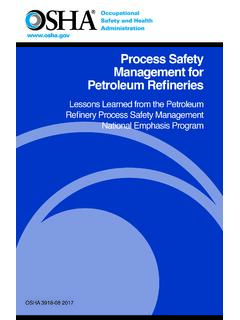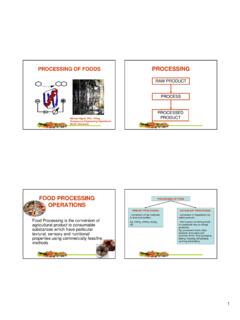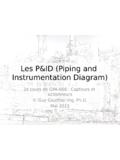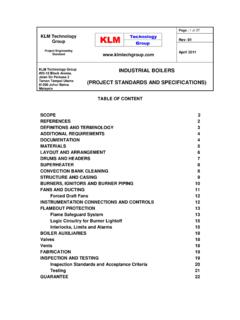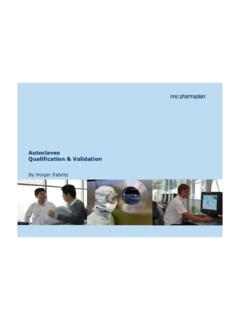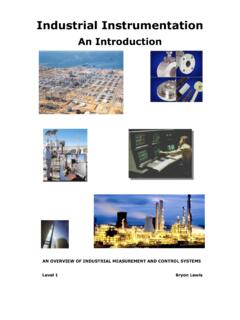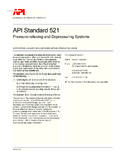Transcription of HAZOP report - PEMBeyond
1 PEMFC system and low-grade bioethanol processor unitdevelopment for back-up and off-grid power applicationsGrant Agreement no: 621218 Deliverable reportDue date of submission beneficiary:VTT Technical Research Centre of Finland LtdAuthors:Janne Sarsama, Minna Nissil , Pauli Koski,Noora Kaisalo, Johan Tallgren, VTTC onfidentiality:PublicRevision:Version -GA no: 621218 Deliverable (11)DeliverabletitleHAZOP reportFCH JUproject officer,e-mailaddressGrant agreement noNikolaos Lymperopoulos, FCH nameProject short namePEMFC system and low-grade bioethanol processor unit de-velopment for back-up and off-grid power applicationsPEMB eyondAuthor(s)PagesJanne Sarsama, Minna Nissil , Pauli Koski, Noora Kaisalo,Johan Tallgren11 pages + 2 AppendicesSummaryThisdeliverable reports theHazard andOperability study ( HAZOP ) of the integrated PEMFC based power system operating on low-grade (crude)
2 Bioethanol that is developed inPEM-Beyond HAZOP study was carried out in the beginning of year 2017 as a part of the integration ofthe individual subsystems into a functioning overall system and related development and de-sign work at VTT. The objective of the HAZOP study was to identify and analyse hazards andoperability problems related to the integrated PEMFC based power system and its operation,and thus provide feedback to the ongoing integration and development work, by suggestingpossible improvements to the design or operation of the first section of this report gives an introduction, followed by the second section describingthe system under study.
3 The implementation of the HAZOP study is reported in section three,followed by , the piping and instrumentation diagram and HAZOP worksheets are included -GA no: 621218 Deliverable (11)ContentsContents .. and study objective .. of the studied system .. of the HAZOP study .. of the HAZOP method .. of the study and study limitations .. of study, meetings organised, participants of study group .. 8 References .. 11 Appendix A HAZOP worksheetsAppendix B piping and instrumentation diagram (P&ID)PEMB eyond -GA no: 621218 Deliverable (11) and study objectiveThis Deliverable deals with theHazard andOperability study ( HAZOP ) of the integratedPEMFC based power system operating on low-grade (crude) bioethanol that is developed inPEMB eyond project.
4 The system is intended for back-up and off-grid power generation and ituses crude bioethanol as primary fuel to produce electricity (see ). The system consistsof the following four main subsystems (Koski et al. 2016): Bioethanol fuel processor (later FP) Pressure swing adsorption unit for H2 purification (PSA) PEMFC system (FCS) Higher level control system concept showing the flow of fuel (bioethanol & water) through fuelprocessing and purification, finally entering the fuel cell system. (Koski et )As a part of the integration of the individual subsystems into a functioning overall system andrelated development and design workVTT Technical Research Centre of Finland Ltd (laterVTT) carried out a HAZOP study for the system in the beginning of year 2017.
5 The objectiveof the HAZOP study was to identify and analyse hazards and operability problems related tothe integrated PEMFC based power system and its operation, and thus provide feedback tothe ongoing integration and development work, by suggesting possible improvements tothe design or operation of the of the studied systemThe following description of the studied system is based on Koski et al. (2016) article and thesystem piping and instrumentation diagram given in Appendix B. The description is focusedon the steady state operation of the system as this was the studied operation mode in theHAZOP study carried out (see ). In addition to Koski et al.
6 (2016) article there exist alsomore detailed system descriptions but these are not public, so that s why the article in questionhas been used as a reference fuel processorThe fuel processor (FP) includes a steam reformer reactor (SRR) and a water gas shift reactor(WGSR) integrated together with in an elaborate configuration of afterburners (AFBs) and heatexchangers (HXs). At steady state operation, most of the heat required in fuel processor isPEMB eyond -GA no: 621218 Deliverable (11)produced from the PSA tail gas. In addition, small amounts of ethanol may be dosed to AFB1and AFB2 to sustain stable operation on-site H2generation the fuel processor is fed with a mixture of H2O and EtOH, so that thesteam to carbon (S/C) ratio is 4:1.
7 The feed is divided into two evaporators (EVA1 & 2) heatedby afterburners (AFB1 & 2). The gaseous ethanol steam mixture proceeds to the steam re-former, operated at about 730 C and 8,5 bar(g).The produced reformate gas is cooled to 400 C before entering the WGS reactor (260 400 C), where CO is converted to CO2, reducing the CO content of 7 vol-% at SRR outlet to 0,3vol-% at WGSR outlet (based on simulation). The gas is finally cooled down in COND1 to 20 C, condensing the high pressure of the fuel processor feeds (H2O and EtOH) allows the FP to feed the PSAdirectly without a compressor. By volume, the gas feed to PSA should contain 70,7 % H2, 24,4% CO2, 3,5 % CH4, 0,5 % CO and 0,9 % swing adsorption unitThe pressure swing adsorption (PSA) unit separates the H2 from reformate gas produced bythe fuel processor.
8 PSA unit employs multi-bed processes with complex valving between thefeed stream, the beds and the product stream. The target is to reach CO content < 20 ppm inthe purified H2, with 70 % H2 the PSA unit the purified H2flows through a buffer tank (H2 tank in P&ID in Appendix B)to the fuel cell system (FCS). Before entering the FCS H2pressure is reduced by pressurereducer (PR1) to bar(g). Tail gas from the PSA unit contains combustible componentsand is used for heat production in fuel processor (in AFB1 and AFB2).Fuel cell system with power electronicsThe fuel cell system (FCS) comprises of a PEMFC stack, balance of plant (BoP) componentshandling H2, air and coolant delivery to the stack, power electronics including the Li-ion batterypack and the FCS control system.
9 The 100-cell stack in the FCS features automotive type steelbipolar plates and reformate MEAs. The nominal operation point is at 0,6 A/cm2 with the esti-mated power production around 7-9 kW depending on the final H2 Implementation of the HAZOP of the HAZOP methodAccording to the standard IEC 618821 HAZOP is a structured and systematic examination ofa planned or existing process or operation in order to identify and evaluate problems that mayrepresent risks to personnel or equipment, or prevent efficient operation. A suitably experi-enced multidisciplinary team ( HAZOP team) normally carries it out during a set of IEC 61882 Hazard and operability studies ( HAZOP studies) Application guide (2001).
10 PEMB eyond -GA no: 621218 Deliverable (11) HAZOP deals with the identification of potential deviations from the design intent, examinationof their possible causes and assessment of their consequences. The objectives of a HAZOP study are: to identify potential hazards in the system, to identify potential operability problems and in particular the causes of operational dis-turbances with the is based on the use of guidewords, which question how the design intention might notbe achieved at each part2 of the primary strength of HAZOP is that it presents a systematic, disciplined and documentedapproach. To achieve full benefits from a HAZOP study, it has to be properly documented andfollowed up.
